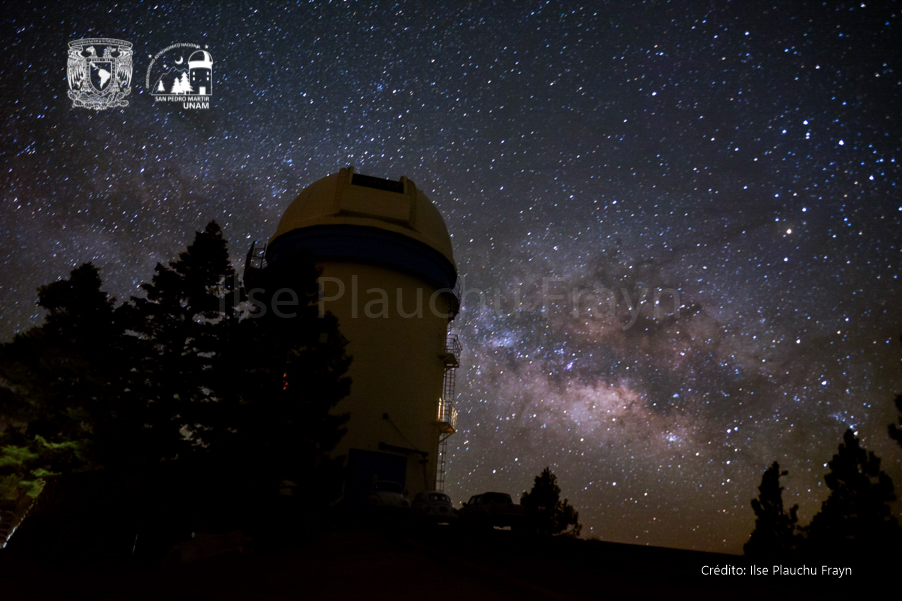San Pedro Mártir National Astronomical Observatory (OAN-SPM)
|
The OAN-SPM currently operates ten telescopes with the diameters 2.1m, 1.5m, 1.3m (three telescopes), 1.0m, 0.84m, 0.60m, 0.50m and an array of six telescopes of 0.28m, which are installed on the Sierra de San Pedro Martir in Baja California, northwestern Mexico. Although the history of the observatory dates back to the 1960s, it is in 1971 when professional activities began on this site, with the installation of the telescopes: 1.5 m and 0.84m. Later in 1979, the 2.1m telescope was inaugurated. More recently, several robotic telescopes were included: 0.60m telescope (BOOTES-5) in 2015, 0.50m telescope (COATLI) in 2016, 0.28m telescope (DDOTI) in 2017, 1.0m telescope (SAINT-EX) in 2019 and three 1.3m telescopes (TAOS-II) in 2020.
|
|
The mission and goals of the observatory include: ♦ To minimize the impact of the telescope operations on the environment, especially inside the San Pedro Mártir National Park. ♦ To address the needs of all observers. ♦ To promote an open and participatory process of planning staff, encouraging everyone to take initiative and high sense of responsability. ♦ Although the observatory is a research center in the first instance, to attend, as far as possible, the public interested in astronomy that visit the observatory.
|
|
The highest point of the OAN-SPM is located at 2830m above the sea level on the sierra of the same name. It is a privileged location for astronomical observations. |
Brief history of the OAN-SPM |
♦ 1867. The National Observatory was initially created in Palacio Nacional in Mexico City. ♦ 1878. The Observatory was moved to the Chapultepec Castle and inagurated on May 5th. ♦ 1908. The Observatory was moved to Tacubaya. ♦ 1929. National Autonomous University (UNAM) was put in charge of the administration and operation of the Observatory. ♦ 1951. The Observatory station is founded in Tonantzintla, Puebla. ♦ 1961. The 1m telescope in Tonantzintla is inaugurated. ♦ 1967. The Institute of Astronomy of UNAM is created. ♦ 1971. UNAM sets up the 0.84m and 1.5m telescopes in the San Pedro Martir National Park. ♦ 1979. UNAM inaugurates the 2.1m telescope, currently one of the world's best in its class. ♦ 1983. The Institute of Astronomy develops the Mepsicron detector, the most advanced of its kind in the world as of that time, and it uses the 2.1m telescope with one of its spectrographs. ♦ 1989. UNAM together with the TEC de Monterrey are the first Mexican institutions connected to the international network (a.k.a. internet) and the OAN-SPM is connected via satellite links. ♦ 1995. The 2.1m telescope becomes the first classical telescope to possess active optics, through a set of pneumatic actuators (air bags). ♦ 2010. The robotic telescope dedicated to monitoring seeing conditions starts operations on site. ♦ 2011. The 1.5m telescope starts astronomical observations in a robotic mode. ♦ 2012. The RATIR instrument is coupled to the 1.5m telescope within the framework of collaboration with NASA. ♦ 2015. The BOOTES-5 robotic telescope is inaugurated in collaboration with the Institute of Astrophysics of Andalucia in Spain and the University of Sungkyunkwan in South Korea. ♦ 2016. The 2.1m telescope became the first push-pull classical telescope, using vacuum as geleralized pull. ♦ 2016. The robotic telescope COATLI starts operations. ♦ 2017. The robotic telescope DDOTI starts operations. ♦ 2019. The robotic telescope SAINT-EX starts operations. ♦ 2020. The three robotic telescopes TAOS-II start operations. |



